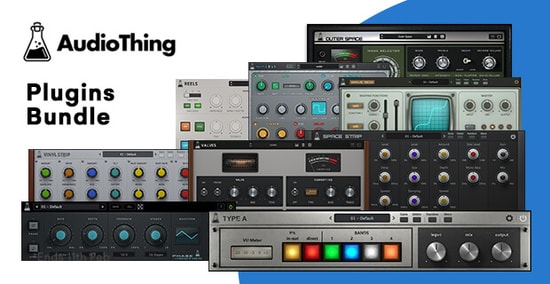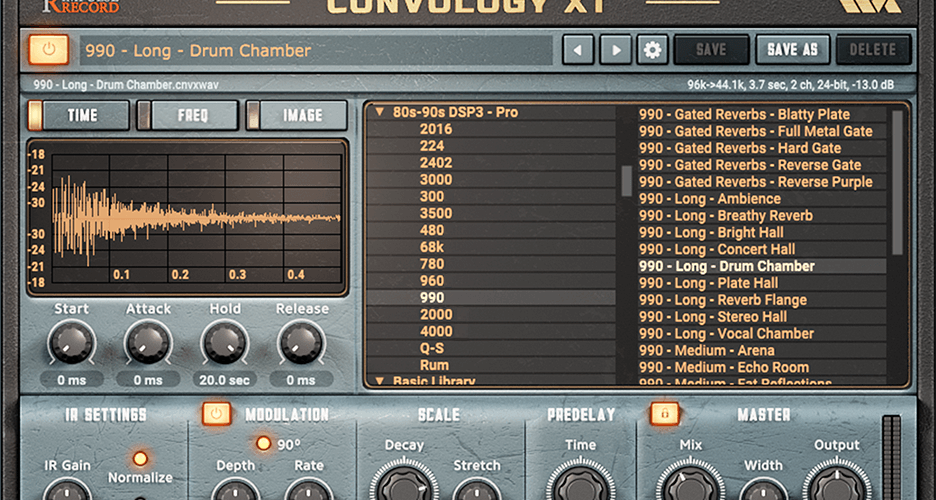The second of three plugins in our list by convolution specialists LiquidSonics sees developer Matthew Hill aiming to create the ultimate room reverb for professional sound designers working in surround formats up to 7.1.6 – but Cinematic Rooms is equally viable for stereo music production too. Convolution reverb is one of the more powerful tools in the sounds designer's arsenal, but one which many desktop musicians find mysterious and confusing, or are simply unaware of. Let's take a look at how convolution reverb works and offer some suggestions for using convolution as a creative sound design tool. A Brief History of Digital Reverbs. At LiquidSonics, convolution reverb is a hobby. Incidentally, Reverberate is their main software. It allows you to have a 'true stereo' convolution reverb (where both channels are completely independent), without latency. Reverberate is Mac and Windows compatible, and it includes 250 presets and 400 Mb of impulse responses.
on Sep 22, 2017 in Recording & Production 0 comments
Convolution reverb is one of the more powerful tools in the sounds designer's arsenal, but one which many desktop musicians find mysterious and confusing, or are simply unaware of. Let's take a look at how convolution reverb works and offer some suggestions for using convolution as a creative sound design tool.
A Brief History of Digital Reverbs
Beginning in the late 1980s with the advent of personal computer-based digital audio processing, one of the Holy Grails of the music software community was realistic digital reverb. Hardware digital reverbs had been around for some time before then, going back to the EMT 250, first released in 1976. But digital reverb software had to wait until personal computers got fast enough, and RAM cheap enough, to make an acceptable digital reverb plug-in possible.
Among the first was Waves' TrueVerb, which provided, at last, an excellent-sounding digital reverb in a not-too-painfully priced package. But like all the hardware reverbs that proceeded it, it was an algorithmic system - it used software formulae, or algorithms, to simulate the way real acoustic reverb worked. That's not to say that algorithmic reverbs sound unrealistic - they can be quite realistic. And at any rate, realism isn't always the goal in music and sound production.
Convolution Reverb Free
But for those who wanted to recreate real acoustic spaces as accurately as possible, algorithmic reverbs didn't quite measure up. It was only with the release of the first convolution reverb software, Audio Ease's Altiverb, in 2001, that those goals were finally realised.
Altiverb stood alone as the only available convolution reverb for several years, but now there are quite a few contenders in the convolution reverb market, including even some open source and freeware versions. Now that computers are powerful enough to support the technology's heavy processing requirements, convolution reverb offers unprecedented accuracy in the reproduction of real acoustic spaces, along with the creation of all types of artificial and virtual spaces, as well as some creative sound design possibilities previously unavailable.
But having said all that, what exactly is convolution reverb?
What Is Convolution Reverb
Convolution Reverb Algorithm
Basically, a convolution reverb takes an input signal (the sound to be reverberated) and processes it with the sound of an actual or virtual acoustic space to create the illusion that the input was recorded in that space. The sound of the acoustic space is captured in what is called an impulse response (IR), which often starts as a recording of a short, sharp sound, such as the firing of a starter pistol or the bursting of an inflated balloon (the impulse), in the acoustic space in question. As you can imagine, such a sound excites the reverberation (the response) in the space, and so the impulse response (or at least its initial recording) sounds like an explosion followed by the reverb reflections of the space.
The trigger sound is usually a somewhat broadband sound like a shot or balloon pop, because the impulse response recording should capture the widest range of frequencies in the reverb reflections possible for as accurate a recreation as possible. And, of course, for stereo convolution reverbs, you need to capture a stereo recording; for surround reverbs, you need a surround recording.
Once captured, depending on the convolution reverb software in question, the IR recording may need to be processed to remove the original impulse trigger sound and leave just the response, a process called deconvolution. Many convolution reverbs, however, don't require this step.
Once you have the IR for the space as a file, you then load it into the convolution reverb and input your sound to be processed. At that point, the software convolves the two digital audio signals together to create the output. Convolution itself is a mathematical process that has many applications including statistics, image processing, and electrical engineering as well as audio processing. I'm not going to try to explain the actual formula (mainly because I don't totally understand it myself), but you don't need to know what's happening to hear the results. If you like, you can think of convolution as a kind of multiplication of each sample of the input with each sample of the IR, with the result being that the input takes on the sonic characteristics of the space in which the IR was recorded.
How It Sounds

Here are some examples of convolution reverb in action - I'm going to use the ImpulseVerb plugin bundled with Bias PEAK, a simple convolution reverb which includes a number of real-world and virtual space IRs.
Here's the dry input sound - a single hit on a cowbell (you can never have too much cowbell, right?):

To use ImpulseVerb, you apply it to your audio file and in the dialog choose one of the included IRs - helpfully, ImpulseVerb includes pictures of the space in the IR was recorded, in this case a hallway:
The ImpulseVerb GUI
After application, here's the resulting sound:

Here's the same cowbell, but this time, convolved with an IR recorded in Trinity Church in Boston, a much larger space:
As you can hear, the results are quite realistic. In fact, because this IR was recorded in the actual church, the results of the convolution should be indistinguishable from the cowbell recorded live in the church (assuming the same acoustic conditions in each case.)
In fact, that's one of the important uses of convolution reverb - the ability to recreate the sounds of actual spaces remotely. It's used often in film and video production, where you may have dialog or ambient sound recorded on location that needs to be replaced in post-production - a very common scenario. In that case, location recorders and sound effects engineers will frequently record an impulse response at the location, then use that IR later in post to make the replacement dialog or effects sound as if they were recorded live at the location. It's much easier, and usually more accurate, to recreate the ambience of the location that way instead of trying to simulate it with algorithmic reverbs.
Space Designer
As you saw, the controls you have available in ImpulseVerb are pretty basic, and don't really allow you to adjust the frequency response, room size, or reverb time the way you may be used to in algorithmic reverbs. Many convolution reverbs still work this way - the only way you can really modify the reverb is to modify the IR. But more current convolution reverbs do allow for much greater customization of the final reverb, and one of those is Logic's own Space Designer, an advanced convolution reverb:
Logic Pro's own convolution reverb, Space Designer

We won't go into the details of Space Designer right now, but as you can see, it's much more tweakable than ImpulseVerb - you can adjust the decay and attack of the IR with the Volume Envelope, filter the resulting reverb with a Filter Envelope (note the bezier handles on the filter shape so you can create smooth envelope curves) and much more.
Space Designer is a tweakers paradise.
But what I'd really like to point out here is that Space Designer has the ability to load any uncompressed audio file as an IR, which provides for some powerful and unique sound design possibilities.
Sound Design with Space Designer
Many convolution reverbs only allow files of a specific type to be used as IRs - as I mentioned, they often need to be pre-processed to be usable as IRs. And many convolution reverbs only allow files of a short duration, perhaps only a few seconds, to be loaded in as IRs. But Space Designer not only lets you load in regular AIFF files as IRs, but those files can be of a length limited only by the amount of RAM in your system.
Another important consideration is that the sound you load in as an IR in Space Designer doesn't have to be an actual IR - that is, it doesn't have to be a recording of an actual impulse in a real space. Since Space Designer can accept any audio file, you can use any audio file as your IR, and the results can give you sounds that you can't get any other way.
For example, here's a short bit of me playing the EVP88 Electric Piano softsynth through a standard room reverb in Space Designer:
And here's an ambient pad played on another synth:
And here's the result of loading in the pad as the IR in Space Designer for the same EP track:
It's a completely different sound and feel, but the results still have elements of both the original track and the pad used for the IR.
Here's a completely different sound - one of those plastic tubes that whistle when twirled overhead:
And what happens when it's used as an IR for the EP track:
Convolution Reverb Ableton
As you can hear, a completely different sound, but one which still retains elements of both sources. The possibilities when using non-standard sounds as IR files in Space Designer are literally endless.
Well, I hope that's cleared up some of the mysteries of convolution reverb for you - if you're a Logic user, I encourage you to experiment with Space Designer to see where it leads you. If you have access to another convolution reverb, try some of these ideas there too. And as always, have fun.
Related Videos
In audio signal processing, convolution reverb is a process used for digitally simulating the reverberation of a physical or virtual space through the use of software profiles; a piece of software (or algorithm) that creates a simulation of an audio environment. It is based on the mathematical convolution operation, and uses a pre-recorded audio sample of the impulse response of the space being modeled. To apply the reverberation effect, the impulse-response recording is first stored in a digital signal-processing system. This is then convolved with the incoming audio signal to be processed.
Creation of impulse responses[edit]
Directly recording impulses[edit]
An impulse response is a recording of the reverberation that is caused by an acoustic space when an ideal impulse is played. However, an ideal impulse is a mathematical construct, and cannot exist in reality, as it would have to be infinitesimally narrow in time. Therefore, approximations have to be used: the sound of an electric spark, starter pistol shot or the bursting of a balloon, for instance. A recording of this approximated ideal impulse may be used directly as an impulse response. Techniques involving starter pistols and balloons are sometimes referred to as transient methods, and the response is contained at the beginning of the recording in an impulse.
Sine sweep method[edit]
Another technique, referred to as the sine sweep method, covers the entire audible frequency range, which can result in a broader-range, and higher-quality, impulse response. This involves the use of a longer sound to excite a space (typically a sine sweep), which is then put through a process of deconvolution to produce an impulse response. This approach has the advantage that such sounds are less susceptible to distortion; however, it requires more sophisticated processing to produce a usable impulse response.
Maximum Length Sequences[edit]
A third approach involves using maximum-length sequences. This uses a constant-power signal instead of an impulse, so does not require as much dynamic range when recording.[1]
Construction based on transfer function[edit]
The transfer function (or frequency response) of a system can be measured using any sound that covers the frequency spectrum. For example, to sample the acoustic properties of a larger space such as a small church or cathedral, the space can simply be excited using white noise, with the result recorded both near the source, and somewhere else in the space.
The coefficients of a finite impulse response can then be generated as the inverse Fourier Transform of the cross-correlation of the output of the system with the auto-correlation of the input to the system. This is difficult in practice because such sequences are highly susceptible to distortion.[citation needed]
Applications[edit]
Real space simulation[edit]
The primary goal of a convolution reverb is to sample real spaces, in order to simulate the acoustics of the sampled space. A straightforward and simple mono example of capturing an impulse response would be to set up a microphone in a concert hall and to place the microphone in the centre of the auditorium. Next, produce a very brief pulse (often an electric spark) of sound, and record everything that the microphone picks up, which includes both the original sound and the response of the room to it. The recorded take would then be cleanly edited and loaded into the convolution processor. This convolution can be applied as part of a signal processing chain.
Machine simulation[edit]
It is also possible to sample the impulse response of a reverberation unit, instead of sampling a real space. Thus, it is possible to use a convolution reverb in place of a hardware machine. The techniques used to sample a reverberation unit are the same as the ones used to sample real spaces.
Electronic music[edit]

In electronic music convolution is the imposition of a spectral or rhythmic structure on a sound. Often this envelope or structure is taken from another sound. The convolution of two signals is the filtering of one through the other.[2] See applications of convolution.
References[edit]
- ^http://www.libinst.com/mlsmeas.htm
- ^Zölzer, Udo, ed. (2002). DAFX:Digital Audio Effects, p.48–49. ISBN0471490784.
External links[edit]
- Acoustical Impulse Response Measurement with ALIKI: Includes comparison of methods for creating impulse responses
- Freeverb3 Impulse Response Processor: Opensource zero latency impulse response processor with source code; also includes a few different algorithmic reverberators
- Freeverb3 VST plugins A package of VST DSP effect plugins utilizing the Freeverb3 signal processing library.
- University of York, OpenAIR open source IR Library (over 70 sampled spaces; 2011-2017)